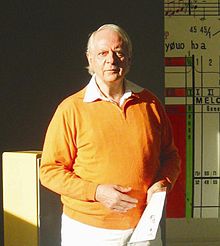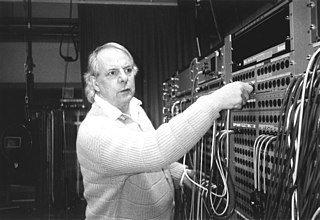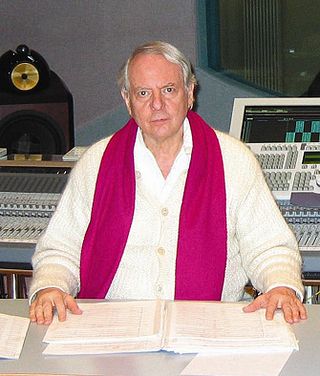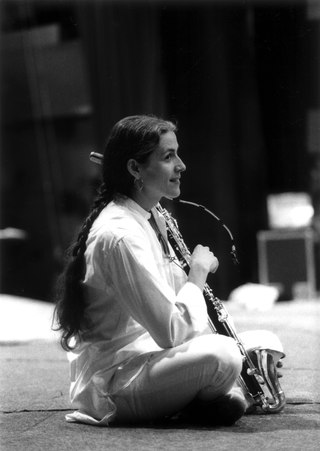
Strahlen (Rays) for a percussionist (vibraphone and/or glockenspiel) and ten-channel sound recording is a composition by Karlheinz Stockhausen, and is Nr. 80½ in his catalog of works. Its performing duration is 35 minutes.

Strahlen (Rays) for a percussionist (vibraphone and/or glockenspiel) and ten-channel sound recording is a composition by Karlheinz Stockhausen, and is Nr. 80½ in his catalog of works. Its performing duration is 35 minutes.
Strahlen was composed in 2002, as a version of Hoch-Zeiten for choir, the fifth scene of Stockhausen's opera Sonntag aus Licht . It was commissioned by the Zentrum für Kunst und Mediatechnologie (ZKM), Karlsruhe, with support from the Kunststiftung Nordrhein-Westfalen. For a performance, any nine of the ten channels of recorded sound are played back, and the remaining part is played live by the soloist. [1]
Work on the ten-channel electronic music for Strahlen was begun in 2003 by the ZKM, but was interrupted in 2004 in favour of producing the visual elements for the third scene of Sonntag, Licht-Bilder . A preliminary version of the recording was used for the world premiere, on the occasion of the tenth anniversary of the ZKM on 4 December 2009, at the Museum für Neue Kunst in Karlsruhe, with László Hudacsek, vibraphone, and Kathinka Pasveer, sound projection. The final version of the electronic music was mixed down to ten tracks by Holger Stenschke and Kathinka Pasveer from 13 to 21 September 2010 at the ZKM. [1]

The work's title suggests an impression of overwhelming radiance. [2] The central idea of the composition is the simultaneous layering of five different tempos. These are chosen in various combinations from a scale of seven metronomic tempos: 30, 40, 53.5, 71, 95, 134, and 180 per minute. The selection of tempos can focus on the faster or slower tempos, or combinations emphasizing the strongest oppositions. Many of the notated durations are longer than the vibraphone can sustain. For this reason, the sounds in the recording are lengthened electronically and amplitude modulated to supply an internal pulsation that defines the tempo for each layer. [1] The pitches are drawn from the five melodic lines of the form scheme for Hoch-Zeiten for choir. This form scheme in turn consists of the final (Sunday) segment of the three-layered Licht superformula, with a superimposed faster version of the entire superformula compressed to the same length (only with the Lucifer layer left out). Each of these five lines is partitioned according to its changes of pitch into seven segments. Because the pitches in the different lines do not always change at the same time, the segmentation is different in each layer, and the composite changes produce a series of slow chord changes with fourteen phases. These fourteen phases also determine the tempo changes in each layer. For example, the five layers at the beginning (from high to low) are in tempos 30, 40, 95, 71, and 53.5. At the second of the fourteen sections, only the second layer changes, from 40 to 134, while the other four layers continue at their previous speeds and pitches. At the third chord, the upper four parts all change immediately, while the lowest layer begins a slow accelerando, and so on. An extra section, corresponding to the final fermata of the superformula, is added at the end. This is a quotation of the Sunday Song from the Sieben Lieder der Tage (Seven Songs of the Days), from Evas Lied , act 2, scene 4 of Montag aus Licht. Two inserts and a short introduction are also added. Each of the five layers is then composed out into two heterophonic parts, bringing the total number of parts to ten. [3]

Karlheinz Stockhausen was a German composer, widely acknowledged by critics as one of the most important but also controversial composers of the 20th and early 21st centuries. He is known for his groundbreaking work in electronic music, for introducing controlled chance into serial composition, and for musical spatialization.

Licht (Light), subtitled "Die sieben Tage der Woche", is a cycle of seven operas composed by Karlheinz Stockhausen between 1977 and 2003. The composer described the work as an "eternal spiral" because "there is neither end nor beginning to the week." Licht consists of 29 hours of music.

The Helikopter-Streichquartett is one of Karlheinz Stockhausen's best-known pieces, and one of the most complex to perform. It involves a string quartet, four helicopters with pilots, as well as audio and video equipment and technicians. It was first performed and recorded in 1995. Although performable as a self-sufficient piece, it also forms the third scene of the opera Mittwoch aus Licht.

Tierkreis (1974–75) is a musical composition by the German composer Karlheinz Stockhausen. The title is the German word for Zodiac, and the composition consists of twelve melodies, each representing one sign of the zodiac.

The Klavierstücke constitute a series of nineteen compositions by German composer Karlheinz Stockhausen.

Klang —Die 24 Stunden des Tages is a cycle of compositions by Karlheinz Stockhausen, on which he worked from 2004 until his death in 2007. It was intended to consist of 24 chamber-music compositions, each representing one hour of the day, with a different colour systematically assigned to every hour. The cycle was unfinished when the composer died, so that the last three "hours" are lacking. The 21 completed pieces include solos, duos, trios, a septet, and Stockhausen's last entirely electronic composition, Cosmic Pulses. The fourth composition is a theatre piece for a solo percussionist, and there are also two auxiliary compositions which are not part of the main cycle. The completed works bear the work (opus) numbers 81–101.

Montag aus Licht is an opera by Karlheinz Stockhausen in a greeting, three acts, and a farewell, and was the third of seven to be composed for the opera cycle Licht: die sieben Tage der Woche. The libretto was written by the composer.

Suzanne Stephens is an American clarinetist, resident in Germany, described as "an outstanding performer and tireless promoter of the clarinet and basset horn".

Kathinka Pasveer is a Dutch flautist.

Sonntag aus Licht is an opera by Karlheinz Stockhausen in five scenes and a farewell, to a libretto written and compiled by the composer. It is the last-composed of seven operas that comprise the cycle Licht (Light). Its stage premiere in 2011 was posthumous, more than three years after the composer's death.

Samstag aus Licht is an opera by Karlheinz Stockhausen in a greeting and four scenes, and was the second of seven to be composed for the opera cycle Licht: die sieben Tage der Woche. It was written between 1981 and 1983, to a libretto written by the composer and incorporating a text by Saint Francis of Assisi, and was first staged in Milan in 1984.

Donnerstag aus Licht is an opera by Karlheinz Stockhausen in a greeting, three acts, and a farewell, and was the first of seven to be composed for the opera cycle Licht: die sieben Tage der Woche. It was written between 1977 and 1980, with a libretto by the composer.

Dienstag aus Licht is an opera by Karlheinz Stockhausen in a greeting and two acts, with a farewell, and was the fourth of seven to be completed for the opera cycle Licht: Die sieben Tage der Woche. It was begun in 1977 and completed from 1988 to 1991, to a libretto by the composer.

Mittwoch aus Licht is an opera by Karlheinz Stockhausen in a greeting, four scenes, and a farewell. It was the sixth of seven to be composed for the opera cycle Licht: die sieben Tage der Woche, and the last to be staged. It was written between 1995 and 1997, and first staged in 2012.

Musik im Bauch is a piece of scenic music for six percussionists and music boxes composed by Karlheinz Stockhausen in 1975, and is Number 41 in his catalog of works. The world premiere was presented on 28 March 1975 as part of the Royan Festival. The performance was given by Les Percussions de Strasbourg in the haras in the town of Saintes, near to Royan. Its duration is roughly 38 minutes.
Studie I is an electronic music composition by Karlheinz Stockhausen from the year 1953. It lasts 9 minutes 42 seconds and, together with his Studie II, comprises his work number ("opus") 3.

Stop is a composition for orchestra by Karlheinz Stockhausen, work-number 18 in the composer’s catalogue of works, where two performing realisations are also found as Nr. 18½ and Nr. 18⅔.

Oktophonie (Octophony) is a 1991 octophonic electronic-music composition by Karlheinz Stockhausen. A component layer of act 2 of the opera Dienstag aus Licht, it may also be performed as an independent composition. It has a duration of 69 minutes.

Europa-Gruss is a composition by Karlheinz Stockhausen for wind ensemble with optional synthesizers, and is assigned Number 72 in the composer's catalogue of works. It has a duration of about twelve-and-a-half minutes.

Trumpetent is a quartet for four trumpets by the German composer Karlheinz Stockhausen, written in 1995. It is Number 73 in his catalogue of works and one of four independent compositions related to his opera, Mittwoch aus Licht. A performance lasts about 16 minutes.